Chonsu at Nadura Temple*
By David Klotz
The Roman Period temple of Nadura sits atop a promontory in north-central Kharga Oasis, its lofty position affording clear views of Hibis, Bagawat, and the desert roads leading to the Nile Valley (Figure 1).1 On a clear day, one can see the Abu Sighawal and Refuf passes to the north, Gebel Ghennima to the east, the Bulaq pass to the south, and the entire town of Kharga (ancient Hibis) to the west.
The natural vantage point of the site probably explains its modern name (< Arabic: naẓāra, “place of viewing”),2 and its location was clearly of strategic importance.3 However, neither the temple nor the surrounding settlement has ever been the object of archaeological study, and only brief excerpts of the extensive hieroglyphic inscriptions have been published.4
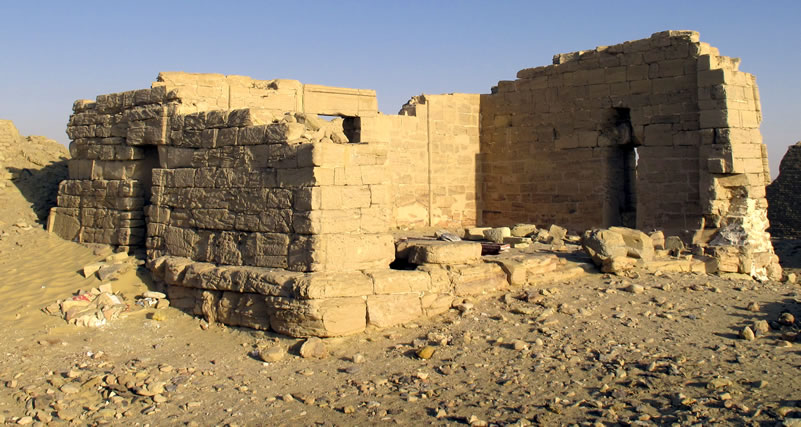
The most important task for understanding the local theology and cultic function of Nadura is to record and translate all carved reliefs and hieroglyphic texts dating to the reigns of Hadrian and Antoninus Pius (117–161 CE).5 Unfortunately, the inscriptions are badly damaged from wind erosion (Figure 2), and the considerable number of lacunae continues to increase as more blocks disappear from the site (Figure 3).6
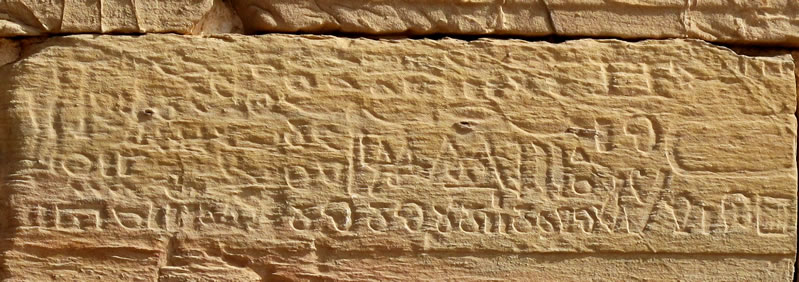
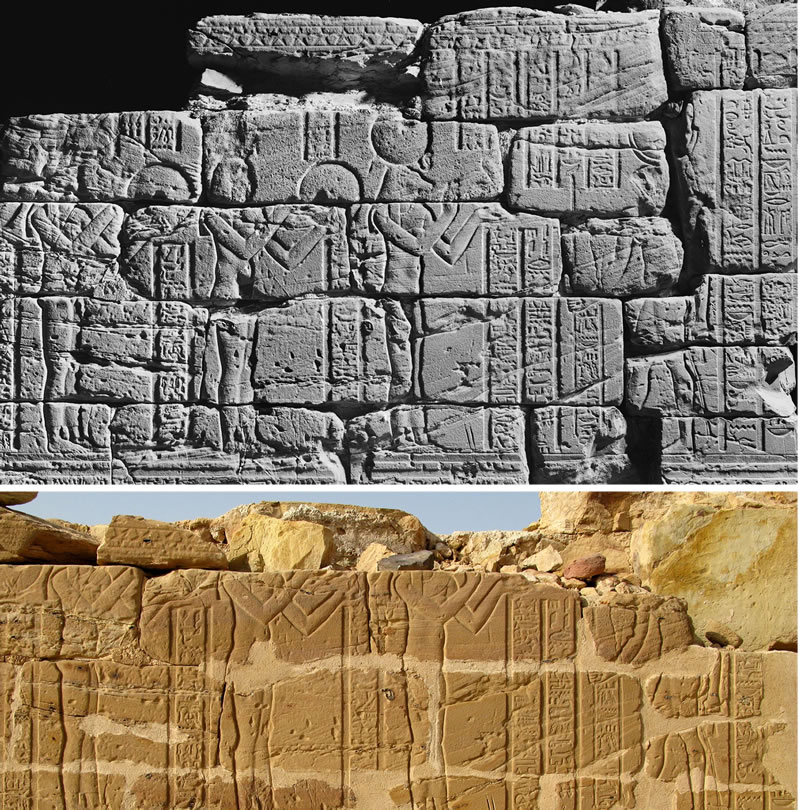
In 2009, the Yale Nadura Temple Project began the complete epigraphic documentation of the reliefs and inscriptions, alongside the architectural and archaeological survey of the entire site. Despite the abysmal state of preservation of some of the hieroglyphs, a facsimile copy is preferable to typeset or autographed hieroglyphs, since only a true epigraphic edition allows other scholars to propose meaningful restorations or alternate readings.7 The documentation project has benefited enormously from archival photographs taken by Jean-François Gout in 1976 at the behest of Serge Sauneron, currently housed in the collection of the IFAO in Cairo.8 Fortunately, these earlier photographs recorded significant portions of texts and reliefs which have since vanished.
Given the fragmentary condition of the temple inscriptions, the careful epigraphic survey is still in progress. Nonetheless, initial copies of the hieroglyphic texts and reliefs allow for an important preliminary observation: identifying the primary divinity of Nadura temple.

Lacking textual evidence, scholars have attributed the temple to different deities. Serge Sauneron suggested the temple belonged to the goddess Mut,9 since she features prominently in one well-preserved scene on the north wall (Figure 4).10 Three Bes-gods play various instruments, Ihy-children shake sistra, and a god wearing the hemhem-crown (almost certainly Thoth)11 raises his arms in adoration, while a goddess and the king agitate even more sistra. As some have already noted,12 this scene is a perfect illustration of the Myth of the Wandering Goddess, where Thoth and the king (wearing the crown of Onuris-Shu) literally entice Mut back from the Western Desert while a musical ensemble pacifies her impending rage. Other scholars have assumed the temple was dedicated to Amun of Hibis, just like Hibis and Qasr el-Zayyan,13 while Dieter Kurth suggested the temple could have belonged to both Amun and Mut.14
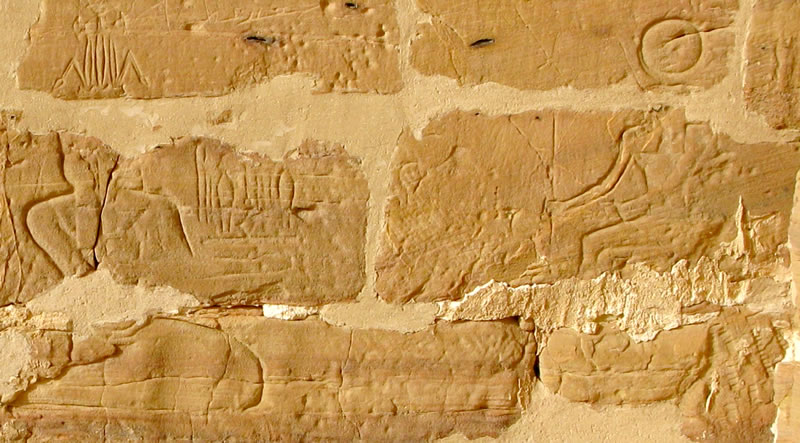
While Amun and Mut naturally feature in certain offering scenes, several details indicate that Chonsu presided at Nadura.15 Clear evidence comes from the fecundity figures on the north and south walls, since they bring offerings specifically to Chonsu (Figure 5).16 In both places Chonsu has a falcon head and a lunar disk, and on the north wall he bears the explicit label: “Chonsu Lord of Hibis” (![]() ). Furthermore, a frieze text on the north wall and two bandeau inscriptions on the north and south walls address the primary divinity in the second person masculine singular.
). Furthermore, a frieze text on the north wall and two bandeau inscriptions on the north and south walls address the primary divinity in the second person masculine singular.
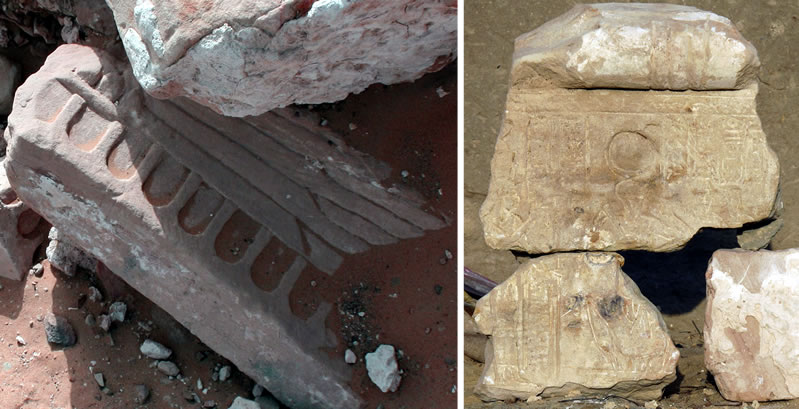
Chonsu actually predominates in the decorative program of Nadura, appearing in the majority of offering scenes on the west wall of the forecourt, while reliefs involving other divinities (Mut, Min, Re-Harakhty) primarily occur on the north and south walls. Furthermore, Chonsu appears twice standing in front of Amun, a unique position of honor he does not occupy elsewhere, not even in the temple of Chonsu at Karnak.
In the 2009 season, the Yale Nadura Temple project began clearance of the mostly razed sanctuary, of which only minor architectural traces were visible prior to excavation.17 While removing the windblown sand, we uncovered a number of inscribed blocks belonging to the sanctuary itself. In addition to common architectural elements — ceiling slabs with star decoration, carved kheker-frieze, and cavetto cornice with a winged sundisk (Figure 6) — there were also several fragments from the portal jambs and lintel, carved in a very similar style to the portal of the forecourt and apparently dating likewise to the reign of Hadrian. One scene depicts the king presenting jugs of milk to Chonsu the Child and Mut (Figure 7). In this relief, Chonsu sits on a lotus and holds his finger to his mouth, a pose that is surprisingly rare for Chonsu.18 Only the right half of the lintel, Amun and Mut feature on the outermost scene (Figure 8), while Chonsu and Mut appear in the central panel, just as on the door of the forecourt. This layout once again underlines the primacy of Chonsu at this temple, particularly within the naos.
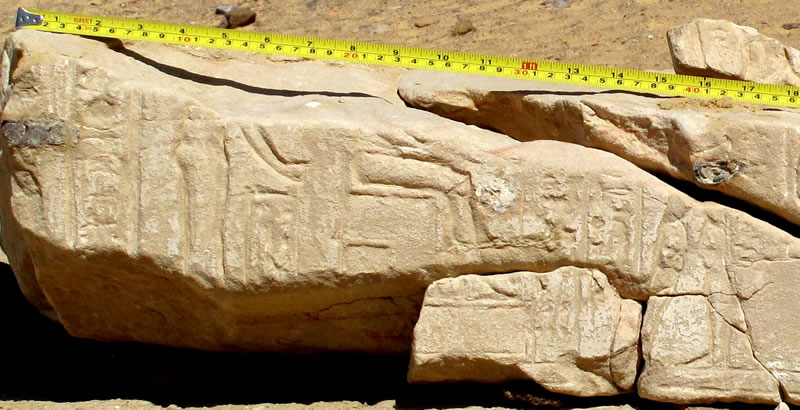
The textual and iconographic evidence overwhelmingly indicates that Chonsu was the primary divinity at Nadura. The hilltop location of this temple suggests a conscious mythological interpretation of the landscape, since Chonsu of Thebes was traditionally associated with a primeval mound and his temple was even named Bnn.t.19 More importantly, the elevated position permits unobstructed viewing of the lunar phases, whereas priests of Chonsu in Karnak were required to make such observations from the temple roof.20
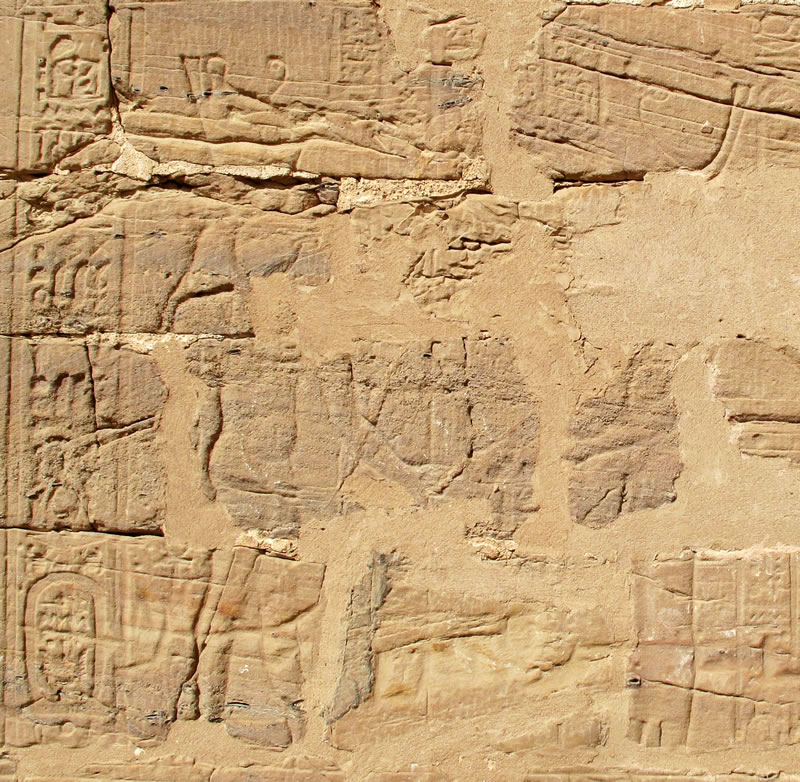
At present, the precise nature of the Chonsu temple remains unclear. The presence of dancing Bes-figures and tambourine-playing goddesses could be indicative of a mammisi. In addition, two remarkable reliefs from the west wall portray Chonsu receiving the royal inheritance. On the south side, Chonsu (spelled: ![]() ) appears as a child wearing the double crown and a cape, receiving years from Nekhbet and wine from the king. The corresponding scene to thenorth features an equally remarkable image of Chonsu as a falcon-headed child (!) who accepts an object from Wadjet (possibly the mks-inheritance document) and offerings from the king (Figure 9). Both representations are atypical for Chonsu the Child,21 but they recall similar coronation scenes from the mammisi of Edfu.22
) appears as a child wearing the double crown and a cape, receiving years from Nekhbet and wine from the king. The corresponding scene to thenorth features an equally remarkable image of Chonsu as a falcon-headed child (!) who accepts an object from Wadjet (possibly the mks-inheritance document) and offerings from the king (Figure 9). Both representations are atypical for Chonsu the Child,21 but they recall similar coronation scenes from the mammisi of Edfu.22
Nonetheless, tambourines are not exclusive to Mammisis, and musicians feature in many other festival contexts, including rooftop processions at the New Year,23 ceremonies for the Wandering Goddess,24 and ritual destruction of enemies.25 Furthermore, unpublished Ptolemaic blocks uncovered at Hibis Temple feature decoration indicative of Mammisis, including hippopotamus-goddesses and multiple reliefs of Mut and Chonsu the Child.26 In Thebes, Chonsu had at least two distinct cult centers: the large temple in Karnak dedicated to Chonsu in Thebes Neferhotep, and a smaller mammisi for Chonsu the Child within the Mut Precinct.27 It is possible that Nadura was the main temple of Chonsu in Kharga Oasis, although he might have also had a separate Mammisi closer to Hibis.
External references to Nadura are lacking at present, although Chonsu appears frequently in the decoration program of nearby temples (Hibis, Ghueita, Qasr el-Zayyan, Dush, and Deir el-Haggar). In his classic study on the Egyptian Oases, Guy Wagner noted that theophoric names formed with Chonsu or Herakles (the standard interpretatio Graeca of the Egyptian deity)28 are extremely popular in documents from Hibis and Bagawat.29 In particular, the name Πετεχῶν occurs much more frequently in Kharga Oasis than in Dakhla,30 reflecting the considerable importance of Chonsu near Nadura. Future seasons of the Yale Nadura Temple Project will undoubtedly shed more light on the local cult of Chonsu and his connection to other Oasis temples.
Notes
- * An expanded form of this article appeared in Göttinger Miszellen 226 (2010), pp. 25-34.
- 1. For the site of Nadura, see primarily B. Porter and R.L.B. Moss, Topographical Bibliography VII, pp. 286, 290-1; S.H. Aufrère, J.-Cl. Golvin, J.-Cl. Goyon, L’Égypte restituée, III: Sites et temples des déserts. De la naissance de la civilisation pharaonique à l’époque gréco-romaine (Paris, 1994), pp. 96-97; J. Willeitner, Die ägyptischen Oasen. Städte, Tempel und Gräber in der Libyschen Wüste (Mainz am Rhein, 2003), pp. 38-39, 41; G. Hölbl, Altägypten im Römischen Reich. Der Römische Pharao und seine Tempel, III: Heiligtümer und religiöses Leben in den ägyptischen Wüsten und Oasen (Mainz am Rhein, 2005), pp. 46-47, 52-54.
- 2. Early travelers called the temple “El Nadera” (A. Edmonstone, A Journey to the Two of the Oases of Upper Egypt [London, 1822], p. 62) and “Nadara” (G.A. Hoskins, Visit to the Great Oasis of the Libyan Desert [London, 1837], p. 131). The form “Nadūrah” first appears in G. Rohlfs, Drei Monate in der libyschen Wüste (Cassel, 1875), p. 312, and G. Schweinfurth, “Notizen zur Kenntniss der Oase El-Chargeh,” Mittheilungen aus Justus Perthes’ Geographischer Anstalt 21 (1875): 390, who first suggested the oft-repeated etymology.
- 3. The surrounding structures are generally described as a fortress. R.S. Bagnall has recently argued that Nadura was the primary military post guarding Hibis (“The Camp of Hibis,” in Essays and Texts in Honor of J. David Thomas, American Studies in Papyrology 42 [Oakville, 2001], pp. 9-10).
- 4. For these excerpts, see H. Brugsch, Reise nach der grossen Oase El Khargeh in der Libyschen Wüste: Beschreibung ihrer Denkmaler und wissenschaftliche Untersuchungen über das Vorkommen der Oasen in den altägyptischen Inschriften auf Stein und Papyrus (Leipzig, 1878), pp. 58–59, pl. V; D. Kurth, “Einige Anmerkungen zum oberen Tempel von Nadura in der Oase Charga,” Diehlheimer Blätter zum Alten Testament 27 (1991): 174–175 (available at: http://www1.uni-hamburg.de/Edfu-Projekt//Kurth_Nadura.pdf).
- 5. Most of the decoration dates to Antoninus Pius, but the portal belongs to Hadrian; see J.-Cl. Grenier, Les titulatures des empereurs romains dans les documents en langue égyptienne, PapBrux 22 (Brussels, 1989), p. 56. For the considerable amount of temple activity under these emperors in Kharga and Dakhla, see O.E. Kaper, “Temple Building in the Egyptian Deserts during the Roman Period,” in Kaper, ed., Life on the Fringe: Living in the Southern Egyptian Deserts during the Roman and early-Byzantine Periods, CNWS Publications 71 (Leiden, 1998), pp. 149, 151.
- 6. See D. Kurth, “Antikenraub in den Oasen,” Göttinger Miszellen 130 (1992): 45-48, for the most glaring example. Cf. also H. Beinlich, J. Hallof, “Found and Lost – ein Block aus Deir el-Hagar unterm Hammer,” Göttinger Miszellen 195 (2003): 7-11.
- 7. While typeset copies have long been the norm for Graeco-Roman temple publications, understandable given the vast quantity of inscriptions contained in most of the larger temples, facsimile copies are quickly becoming standard; see notably P. Dils, Der Tempel von Dusch: Publikation und Untersuchungen eines ägyptischen Provinztempels der römischen Zeit (PhD Diss; Cologne, 2000; available at http://kups.ub.uni-koeln.de/volltexte/2006/1614); H. Willems, F. Coppens, and M. de Meyer, The Temple of Shanhûr, I: The Sanctuary, the Wabet, and the Gates of the Central Hall and the Great Vestibule (1-98), OLA 124 (Leuven, 2003).
- 8. S. Sauneron, Les travaux de l’Institut français d’archéologie orientale en 1975-1976,” BIFAO 76 (1976): 411, §603. Dr. Nadine Cherpion kindly provided high-resolution scans of all IFAO photographs from Nadura.
- 9. S. Sauneron, “Les temples gréco-romains de l’Oasis de Khargeh,” BIFAO 55 (1955): 25 (http://www.ifao.egnet.net/bifao/Bifao055_art_03.pdf).
- 10. PM VII, 291 (9); cf. already Hölbl, Altägypten im Römischen Reich, III, p. 53, Abb. 78.
- 11. Compare a similar scene at Dush in which Thoth praises Isis: Dils, Der Tempel von Dusch, pl. 75. 12. Kurth, Diehlheimer Blätter zum Alten Testament 27 (1991): 174; Willeitner, Die ägyptischen Oasen, p. 41.
- 13. R. Naumann, “Bauwerke der Oase Khargeh,” MDAIK 8 (1939): 10; A. Fakhry, “Charga Oasis,” LÄ I, col. 909; Willeitner, Die ägyptischen Oasen, p. 41. Hölbl, Altägypten im Römischen Reich, III, p. 46, specified that Nadura was actually a processional bark station for Amun of Hibis.
- 14. Kurth, Diehlheimer Blätter zum Alten Testament 27 (1991): 173-175, prudently concluding: “Genaueres wird man aber wohl erst nach einer wissenschaftlichen Aufnahme aller Inschriften des Tempels wissen.” E. Cruz- Uribe simply noted that the temple could belong to Amun, Mut, or the Dioscuri (“Kharga Oasis, Late Period and Graeco-Roman Sites,” in K. Bard, ed., Encyclopedia of the Archaeology of Ancient Egypt [London and New York, 1999], p. 407).
- 15. Briefly suggested already by Dils, Der Tempel von Dusch, p. 207, n. 97.
- 16. PM VII, 291 (1)-(3), (9) (incorrectly identifying the god as “Rē‘-Ḥarakhti”).
- 17. Cf. the photograph in Hölbl, Altägypten im Römischen Reich, III, p. 54, Abb. 79.
- 18. For two other examples: R.A. Fazzini, “The Brooklyn Museum’s 2007 Season of Fieldwork at the Precinct of Mut, South Karnak,” ASAE 82 (2008): 71, fig. 3; CG 27572 (C.C. Edgar, Greek Sculpture [Cairo, 1903], pp. 57- 8, pl. 27)
- 19. See D. Mendel, Die kosmogonischen Inschriften in der Barkenkapelle des Chonstempels von Karnak, Monographies Reine Élisabeth 9 (Brussels, 2003).
- 20. H. Jacquet-Gordon, The Temple of Khonsu, vol. 3: The Graffiti on the Khonsu Temple Roof at Karnak: a Manifestation of Personal Piety, OIP 23 (Chicago, 2003), p. 5. For the importance of lunar observations in the cult of Chonsu, see especially F. Labrique, “Khonsou et la néoménie, à Karnak,” in D. Budde, S. Sandri, and U. Verhoeven, eds., Kindgötter im Ägypten der griechisch-römischen Zeit. Zeugnisse aus Stadt und Temepel als Spiegel des interkulturellen Kontakts, OLA 128 (Leuven: Peeters, 2003), pp. 195-224.
- 21. For the iconography of Chonsu the Child in Thebes, see D. Klotz, “The Theban Cult of Chonsu the Child in the Ptolemaic Period,” in Chr. Thiers, ed., Documents de Théologies Thébaines Tardives I, CENiM 3 (Montpellier, 2009), pp. 99-100. While Chonsu the Child often appears as a naked child, he usually sports a side-lock and the lunar disk; the second image of Chonsu as a falcon-headed child god appears to be completely without parallel.
- 22. See E. Louant, “Harsomtus the Child, Son of Horus of Edfu, and the Triple Confirmation of the Royal Power,”in Budde, Sandri, Verhoeven, eds., Kingötter im Ägypten der griechisch-römischen Zeit, pp. 225-49.
- 23. F. Coppens, The Wabet: Tradition and Innovation in Temples of the Ptolemaic and Roman Period (Prague, 2007), pp. 156-7.
- 24. F. Daumas, “Les propylées du temple d’Hathor à Philae et le culte de la déesse,” ZÄS 95 (1968): 1-17; J.C. Darnell, “Hathor Returns to Medamud,” SAK 22 (1995): 47-94.
- 25. W.M.F. Petrie, Athribis (London, 1908), pl. 28; Edfou VI, pl. 146.
- 26. This conclusion is based on personal inspection of the unpublished blocks at Hibis; for a partial description of this material, see already H.E. Winlock, “The Egyptian Expedition,” Bulletin of the Metropolitan Museum of Art 5/10 (1910): 226-8; idem, Hibis I, p. 39, Pl. L.
- 27. For the latter temple, see PM II2, 270-2 (Temple A); H. De Meulenaere, “Isis et Mout du Mammisi,” in J. Quaegebeur (ed.), Studia Paulo Naster oblata II: Orienta Antiqua, OLA 13 (Leuven, 1982), pp. 27-29; R.A. Fazzini, “The Brooklyn Museum’s 2007 Season of Fieldwork at the Precinct of Mut, South Karnak,” ASAE 82 (2008): 68-71; D. Klotz, in Thiers, ed., Documents de Théologies Thébaines Tardives, pp. 97-9.
- 28. See Dils, Der Tempel von Dusch, p. 97, n. 207.
- 29. Wagner, Les oasis d’Égypte, pp. 228 and 235; cf. also D. Devauchelle and G. Wagner, Les graffites du Gebel Teir. Textes démotiques et grecs, RAPH 22 (Cairo, 1984), pp. 53-57; U. Kaplony-Hekel, “Die 28 demotischen Hibis-Ostraka in New York,” Enchoria 26 (2000): 81, for the name ʿnḫ-pȝ-ẖrd / Chapokrates (lit. “may the child live”) in ostraca from Hibis, possibly related to a Chonsu the Child (see Klotz, op. cit.).
- 30. R.P. Salomons and K.A. Worp, Onomasticon Oasiticum: an Onomasticon of Personal Names Found in Documentary Texts from the Theban Oasis in Graeco-Roman Times (2nd internet version; 2009: http://media.leidenuniv.nl/legacy/onomas_final.pdf), pp. 2, 40.
